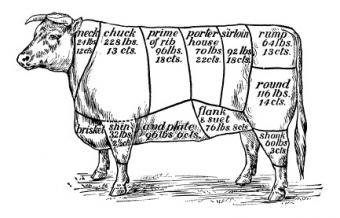
When buying cuts of meat it is important to know which part of the animal the cut comes from and which cut can substitute for another in recipes. You'll also want to be aware of how meat is graded so that you can buy the quality you need for the type of recipe you are creating. This is true no matter what type of meat you are buying, from steak to short ribs.
USDA Grading
USDA grading is based on uniform federal quality standards as inspected and applied by experienced USDA graders. These are the shield-shaped purple marks stamped on the carcass. Supermarket trimming removes most of these stamps, but supermarket retailers put stickers with the USDA's grade shield on meat packages along with descriptive terms describing the meat contained within.
How to Buy USDA Beef
Some supermarkets retail meat processed by private vendors, but the products always have, or should have, labels specifying fat content and quality. Regardless of quality, some cuts are more tender than others. Rib and loin cuts from the back of the animal will always be more tender than those from the shoulder, flank, and leg. Tender cuts are in demand but carcasses contain smaller amounts of these in proportion to other cuts. Tender cuts command higher prices because of enhanced taste and tenderness.
Cuts of Beef
Cuts of beef come from various parts of the cow. Looking at a chart of the various beef cuts can help you understand which cooking process needs to be used.
- The rib, loin and sirloin are the most tender cuts and can usually be grilled, pan fried, or roasted.
- Chuck steaks can be marinated and grilled, otherwise braise or slow cook in a pot roast.
- Round is different depending on the cut. Generally speaking, pot roasting or braising works well, but some cuts can be pan fried.
- Shank and brisket need braising or another slow cooking method to reach tender, full flavor.
Grades
Here are the USDA grading standards you should look for:
- USDA Prime: Prime grade beef that is tender, juicy, and full of flavor. It has abundant marbling which enhances the flavor and juiciness. This grade is perfect for roasting and broiling and is the grade that most restaurants use.
- USDA Choice: Choice contains less marbling than Prime, but still is very high quality. The loin and rib cuts will be very tender, juicy, and flavorful. The less tender cuts like the rump, round, and blade chuck, can be braised or carefully roasted. This is the grade found in many supermarkets' butcher shops.
- USDA Select: A medium quality beef which can be found at most meat counters. It is somewhat leaner than the higher grades and fairly tender, but not as juicy and flavorful because it contains less marbling.
Buying USDA Lamb
The better lamb cuts are produced from younger animals six months to a year old. Quality varies according to age. Using a chart for the cuts of lamb can help you cook it properly.
Cuts
- Shoulder: Broil or roast
- Neck: Braise
- Rib: Roast, broil, or pan fry
- Loin: Broil or pan fry
- Sirloin: Roast
- Leg: Roast
- Foreshank: Braise
- Breast: Roast, braise, or pan fry depending on the individual cut
- Hind shank: Braise
Grades
- USDA Prime: Prime is very tender, juicy, and flavorful. It contains moderate marbling.
- USDA Choice: Choice contains less marbling than Prime, but quality remains high. Chops and roasts are tender, juicy, and flavorful.
- Lower quality grades are seldom marked with grade labels when sold at retail supermarkets.
Older sheep meat is called yearling mutton or mutton and is graded as Choice or below.
Cuts of Pork
Pork is produced from young animals and has less tenderness variability than beef, not only because of age, but because producers have changed their methods of feeding and management. Genetic changes in breeding stock to produce leaner carcasses have also been done and more visible fat is trimmed at processing plants. Because fresh pork products are consistent, USDA grades for pork have just two quality grades: Acceptable and Unacceptable.
When you buy pork, look for cuts with small amounts of fat on the outside, with firm grayish pink meat with a small amount of marbling. For best flavor it should be cooked to internal temperature of 150 degrees F. When pork is cooked properly it is juicy, tender, and slightly pink in the center.
Cuts
Use this file of pork cuts to see where the various cuts of meat come from on the pig:
- Loin: most tender cuts. Roast, grill, or pan fry
- Shoulder: One of the toughest cuts. Smoke, simmer, or braise
- Boston Butt: Pot roast, braise, roast
- Belly: Spare ribs are braised and then grilled while the rest of the belly is used for bacon
- Hind Leg or Ham: Smoke and roast
Where to Buy Online
- Stock Yards offers beef, lamb, pork and hams.
- Omaha Steaks sells cuts of beef, pork, lamb and veal.
Know Your Meat
Knowing the different cuts of meat and how to buy and cook them will help you to always serve them at their peak of flavor and quality. Choose the right cut for your recipe, don't overcook it, and use one of the suggested cooking methods for the best results every time.







